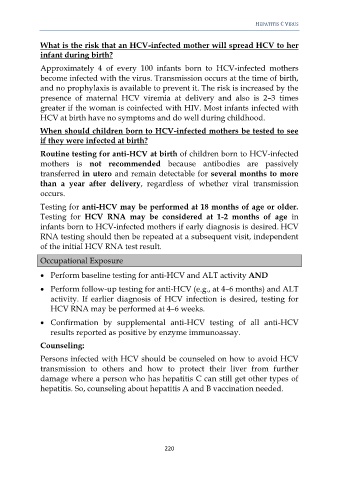Page 251 - fourth year book
P. 251
HEPATITIS C VIRUS
What is the risk that an HCV-infected mother will spread HCV to her
infant during birth?
Approximately 4 of every 100 infants born to HCV-infected mothers
become infected with the virus. Transmission occurs at the time of birth,
and no prophylaxis is available to prevent it. The risk is increased by the
presence of maternal HCV viremia at delivery and also is 2–3 times
greater if the woman is coinfected with HIV. Most infants infected with
HCV at birth have no symptoms and do well during childhood.
When should children born to HCV-infected mothers be tested to see
if they were infected at birth?
Routine testing for anti-HCV at birth of children born to HCV-infected
mothers is not recommended because antibodies are passively
transferred in utero and remain detectable for several months to more
than a year after delivery, regardless of whether viral transmission
occurs.
Testing for anti-HCV may be performed at 18 months of age or older.
Testing for HCV RNA may be considered at 1-2 months of age in
infants born to HCV-infected mothers if early diagnosis is desired. HCV
RNA testing should then be repeated at a subsequent visit, independent
of the initial HCV RNA test result.
Occupational Exposure
Perform baseline testing for anti-HCV and ALT activity AND
Perform follow-up testing for anti-HCV (e.g., at 4–6 months) and ALT
activity. If earlier diagnosis of HCV infection is desired, testing for
HCV RNA may be performed at 4–6 weeks.
Confirmation by supplemental anti-HCV testing of all anti-HCV
results reported as positive by enzyme immunoassay.
Counseling:
Persons infected with HCV should be counseled on how to avoid HCV
transmission to others and how to protect their liver from further
damage where a person who has hepatitis C can still get other types of
hepatitis. So, counseling about hepatitis A and B vaccination needed.
220

